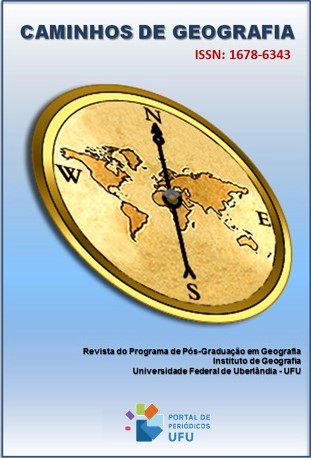VULNERABILIDADE SOCIOAMBIENTAL DA BACIA HIDROGRÁFICA DO RIO CHORÓ – CE
DOI:
https://doi.org/10.14393/RCG249162355Palavras-chave:
Vulnerabilidade Ambiental, Vulnerabilidade Social, Planejamento ambientalResumo
Esta pesquisa busca analisar, numa perspectiva integrada, a vulnerabilidade socioambiental da bacia hidrográfica do rio Choró no estado do Ceará, Nordeste do Brasil. Através da ecodinâmica de Tricart (1977) com adaptações de Souza (2000) é possível estabelecer as condições de vulnerabilidade ambiental dos sistemas ambientais. Aplicou-se a metodologia do IPECE (2010) com adequações de Medeiros (2014) para gerar o Índice de Vulnerabilidade Social – IVS, a partir dos dados socioeconômicos dos setores censitários do IBGE referente aos requisitos: educação, renda, situação social e infraestrutura/habitação. Seguidamente, os dados sistematizados e/ou IVS, por setor, foram espacializados obtendo a vulnerabilidade social da área. A sobreposição dos dados das vulnerabilidades mencionadas resultou no mapa de vulnerabilidade socioambiental. Verificou-se que algumas áreas mais vulneráveis ambientalmente frente às intervenções antrópicas coexistem com a população mais vulnerável socioeconomicamente. As áreas urbanizadas contêm as mais altas vulnerabilidades sociais. Destarte, observa-se que a análise da vulnerabilidade socioambiental tem bastante relevância para o desenvolvimento sustentável da bacia hidrográfica. Com base nessas informações é possível propor ações estratégicas capazes de proporcionar a sustentabilidade e a melhoria da qualidade de vida da população, colaborando, portanto com o ordenamento territorial da área.
Downloads
Downloads
Publicado
Edição
Seção
Licença
Copyright (c) 2023 Patrícia Andrade de Araújo, Marcos José Nogueira de Souza

Este trabalho está licenciado sob uma licença Creative Commons Attribution-NonCommercial-NoDerivatives 4.0 International License.
Autores que publicam nesta revista concordam com os seguintes termos: a) Autores mantém os direitos autorais e concedem à revista o direito de primeira publicação, com o trabalho licenciado sob a Creative Commons Atribuição-NãoComercial-SemDerivações 4.0 Internacional. b) Autores têm permissão e são estimulados a publicar e distribuir seu trabalho online (ex.: em repositórios institucionais ou na sua página pessoal), já que isso pode gerar alterações produtivas, bem como aumentar o impacto e a citação do trabalho publicado. c) Em virtude de aparecerem nesta revista de acesso público, os artigos são de uso gratuito, com atribuições próprias, em aplicações educacionais e não-comerciais.











